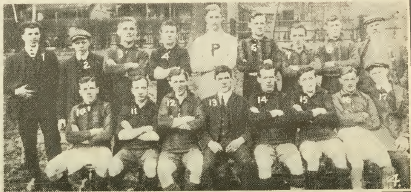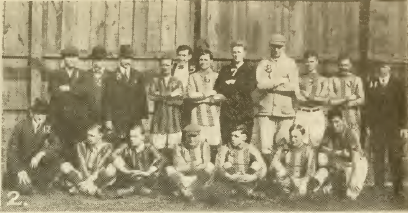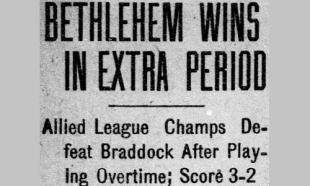Our series on Philly soccer happenings one hundred years ago continues.
The busy Philadelphia soccer schedule continued after the heavy fixture list that bracketed the Thanksgiving holiday with National Challenge Cup and league play.
Six Pennsylvania teams face off in US Open Cup play
The Philadelphia Inquirer wrote of the National Challenge Cup tournament, known today as the US Open Cup, on Dec. 5, 1913 that, given the fact that the tournament was “one of the largest ever attempted” — “the area embraced in the competition is the largest in the world’ — and would determine the “champions of the United States,” it was only natural that “a great deal of interest [was] being taken in the various games” taking place in the second round of the tournament on Dec. 6. In all, 32 American amateur and professional clubs would meet in the second round, six of which were Pennsylvania teams. Meeting in Philadelphia would be West Philadelphia and Kensington AA of the amateur Allied League. Also playing in Philadelphia would be Allied League side Peabody against Wissinoming of the professional Pennsylvania League. Reigning Allied League champions Bethlehem would travel overnight by “a special Pullman” for the long train ride to Pittsburgh to face Braddock FC, champions of western Pennsylvania.
Playing at 44th Street and Parkside Avenue, West Philadelphia made quick work of Kensington, defeating the visitors 4-1, with center forward Ligett and inside left Anderson each scoring a brace in the win. In what the Inquirer described as “a splendidly fought game” and the “surprise of the season,” amateur side Peabody fought back after going down a goal to the professionals of Wissinoming to record a 1-1 draw and force a replay. That game was scheduled to be played on Dec. 13 at Washington Park, located at 26th and Allegheny.
Out in Pittsburgh, Bethlehem had little time to loosen up after arriving in the morning before their 3 pm kickoff against Braddock at Forbes Field. If the team was weary, they did not show it for, as the South Bethlehem Globe reported on Dec. 8, 1913, the Steelworkers “started off in whirlwind fashion, their passing and combination completely upsetting the Braddock defense.” After 15 minutes of play, future National Soccer Hall of Famer Thomas “Whitey” Fleming put the visitors up 1-0. In the second half, the tables were turned with the home team equalizing and then taking the 2-1 lead midway through the half. But only one minute after Braddock took the lead, Bethlehem was awarded a free kick after one of the home side’s defenders handled the ball. Fleming took the spot kick and scored from 30 yards out.
After 90 minutes of play, the score remained level at 2-2. The Inquirer reported on Dec. 7 that Bethlehem wanted to play a replay in Bethlehem but Braddock, perhaps feeling encouraged by their second half performance or maybe just mindful of the expense of traveling across the state for the replay, “insisted on playing an extra half hour.” Bethlehem agreed and play resumed.
By now, the game had turned quite chippy. The Inquirer described the game as “marked by a little bad feeling” on the part of Braddock while the Globe was more plain spoken. “The game toward the close became very rough and unsportsmanlike due to the inability of the referee to take complete control and the Braddock players deliberately fouled and attempted to injure Bethlehem’s players, several of whom will be out of the game for two or three weeks as a result.”
For 28 minutes, each team battled in search of the winning goal. And then, with time running out, Fleming again proved to be the hero. The Inquirer described the outside left “ran the entire distance dribbling the ball very cleverly and with a splendid shot brought home the victory for Bethlehem.” (Roger Allaway’s history of Bethlehem Steel FC, Corner Offices & Corner Kicks, says the goal came “Two minutes from the end of overtime,” while the Globe says the goal came seven minutes before the final whistle. The Inquirer report says the goal came “just a few minutes before call of time.”)
The Globe wrote, “The fighting spirit and training of the Bethlehems team was never better demonstrated than on Saturday in Pittsburgh and too much credit cannot be given the Bethlehems team for its great victory away from home. Every man on the Bethlehems team did splendid work.” And while that was no doubt true, all agreed that Whitey Fleming was the star.
American Cup draw favors local clubs
The draw for the third round of the American Cup tournament took place on Dec. 7, 1913 and the Inquirer reported on Dec. 8 that the four local clubs remaining in the competition — the professional Hibernian, Tacony, and Victor clubs of the Pennsylvania League and the amateur Bethlehem FC — all “fared extremely well” in winning home-field advantage.
Cricket Club League Best XI loses annual intercity contest
The annual contest pitting an all-Associated Cricket Club League of Philadelphia team against an all-Field Club League of New York and New Jersey was played in Staten Island on Dec. 7, 1913. The year before in Philadelphia on Dec. 9, the Philadelphia side had walloped Field Club League team 6-2. This time, it was the Philadelphia team that lost, going down 3-1 in what the Inquirer described on Dec. 8 as a game that “was splendidly contested and very fast all the way through, but the winners thoroughly deserved their victory.”
Other news
On Nov. 19, 1913, the Inquirer reported that an agreement had been reached between the Amateur Athletic Union, forerunner of the US Olympic Committee, and the recently formed United States of America Football Association, known today as the US Soccer Federation, mutually recognizing the other “as the sole and governing bodies of athletics and association football in the United States.” An Inquirer report on Dec. 3 elaborated, “Not only has the Amateur Association signified through its officials that it will act in compliance with the [USAFA] in regards to amateurism, but it has also approved of amateurs and professionals playing together in soccer football.”
On Dec. 7, 1913, Benjamin Groves, secretary of the USAFA affiliated Football Association of Eastern Pennsylvania and District announced the decision barring member clubs from playing exhibition games on Dec. 20. The reason was simple: The Eastern Pa. organization was organizing a benefit doubleheader to be played on that day at Third and Lehigh. The first game would feature a United League team against an Allied League second division team followed by game featuring a all-Pennsylvania League team against an all-Allied League-United League team.
League play
One Pennsylvania League game was played on Dec. 6, 1913, a 2-2 draw between Tacony and Victor. With Wissinoming engaged in National Challenge Cup play on that day, Hibernian played Reading in an exhibition game at their home grounds, Hibernia Park, located at Second and Lehigh. A well contested first half ended with a 1-1 scoreline, the Hibs tally coming from a Reading own-goal. After that, the professionals proceeded to show their superiority over the visiting amateurs from Reading and the game finished as a 4-1 win for the home team. Future National Soccer Hall of Famer Tommy Swords was among the second half goalscorers.
Despite being comprised of three divisions, only one Allied League game was played, a replay of the Nov. 15 game between Fairhill and Wanderers that was level at 1-1 before being called for darkness. The replay ended with the same scoreline.
Four American League games were played, the winners outscoring the losers 15-2. Seven of those goals came in Philadelphia Electric’s 7-0 destruction of fifth place Frankford Boys’ Club. That game marked the opening of Philadelphia Electric’s new grounds at Fairhill Ball Park, located at Third and Lehigh. The win kept the league-leading Live Wires ahead of second place Boys’ Club, who handily defeated fourth place Victor AA, 4-1. Third place Cardington kept place with the league leaders with a 1-0 win over sixth place Rangers. The Inquirer reported on Dec. 7 that “a wonderfully exciting finish” was necessary for last place Whitehall Rovers to record their first win of the season, a 2-1 victory over seventh place Victoria Plush Mills.
Six United League games were played on Dec. 6, 1913. First place North Philadelphia continued its winning ways with a 2-1 victory over seventh place Logan while second place Boys’ Club stumbled at their home grounds at 62nd and South with a 2-2 draw against fifth place West End. Third Place Christ Church defeated last place Era AA , who were now winless after nine games, 3-0. Fourth place P.H.L. “literally smothered” tenth place Roxborough, nine goals to zero.




Comments